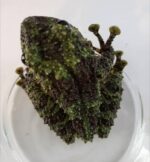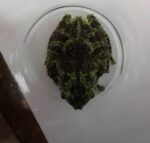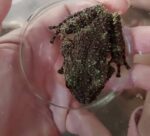Description
Theloderma corticale (common names: mossy frog, Vietnamese mossy frog for sale, Tonkin bug-eyed frog, moss bug-eyed frog, and [for the formerly recognized Theloderma kwangsiense] Kwangsi warty treefrog) is a species of frog in the family Rhacophoridae.The theloderma corticale is often difficult to identify visually as there are cryptic species that look very similar to it.
It has been often confused with theloderma asperum, theloderma stellatum, and theloderma albopunctatum. Using DNA barcoding techniques (extracting and analyzing genetic material from various samples) researchers were able to correctly identify the theloderma corticale and confirm the frog’s range is indeed greater than just northern Vietnam. It is now known to be found in northern Vietnam, south–central Laos, and southern China (Guangdong, Guangxi, Hainan, Yunnan).
Description of Vietnamese Mossy Frog For Sale
The common name “mossy frog” arises from the fact that its skin is a mottled green and brown that resembles moss growing on rock, and forms an effective form of camouflage. They have large sticky pads on their toes and a soft underbelly. They measure about 61 mm (2.4 in) in snout–vent length. The females will grow larger than the males and can reach sizes of 8–9 cm (3.1–3.5 in). This species will curl into a ball when frightened, and play dead.
-
Three individuals camouflaged on a rock face
-
An individual camouflaged on a mossy surface
Habitat of Vietnamese Mossy Frog For Sale
Its natural habitats are primarily evergreen rainforests and subtropical forest where they have been found inside pools in hollowed-out logs, placed by the local villagers. It is semi-aquatic and found in caves and steep rocky cliffs. This frog has been observed between 470 and 1500 meters above sea level. Breeding takes place in rock cavities or tree holes.
Diet of Vietnamese Mossy Frog For Sale
Its diet consists of crickets, cockroaches, and earthworms.
Conservation of mossy frog for sale
Its habitat is threatened by forest loss. It is also collected for the international pet trade. Like many amphibians, the Vietnamese mossy frog is vulnerable to the chytrid fungus Batrachochytrium dendrobatidis. Nonetheless, the conservation of this species is classified as “Least Concern” by the International Union for Conservation of Nature.
A frog is any member of a diverse and largely semiaquatic group of short-bodied, tailless amphibian vertebrates composing the order Anura (coming from the Ancient Greek ἀνούρα, literally ‘without tail’). Frog species with rough skin texture due to wart-like parotoid glands tend to be called toads, but the distinction between frogs and toads is informal and purely cosmetic, not from taxonomy or evolutionary history.
Vietnamese Mossy Frog For Sale are widely distributed, ranging from the tropics to subarctic regions, but the greatest concentration of species diversity is in tropical rainforest and associated wetlands. They account for around 88% of extant amphibian species, and are one of the five most diverse vertebrate orders.
The oldest fossil “proto-frog” Triadobatrachus is known from the Early Triassic of Madagascar (250 million years ago), but molecular clock dating suggests their divergence from other amphibians may extend further back to the Permian, 265 million years ago.
Adult frogs have a stout body, protruding eyes, anteriorly-attached tongue, limbs folded underneath, and no tail (the “tail” of tailed frogs is an extension of the male cloaca). Frogs have glandular skin, with secretions ranging from distasteful to toxic.
Their skin varies in colour from well-camouflaged dappled brown, grey and green, to vivid patterns of bright red or yellow and black to show toxicity and ward off predators. Adult frogs live in both fresh water and on dry land; some species are adapted for living underground or in trees.



























Reviews
There are no reviews yet.